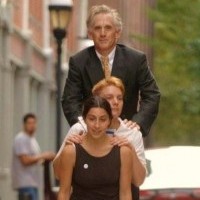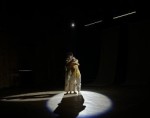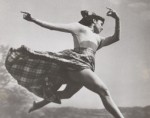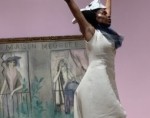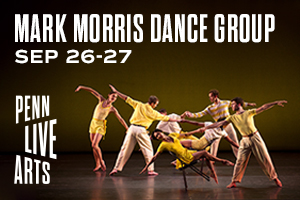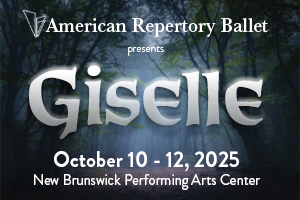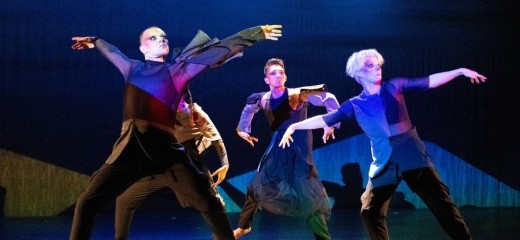
Megan Mazarick’s Searing Subversions
by Jonathan Stein
Megan Mazarick is one of the rare performing artists whose knock-out command of dance and theater connects us directly to the cultural and political zeitgeist. A master image maker–often of darker visions with hints of a transformed future–Mazarick combines tenacious athleticism, sharp satire, and tomfoolery to interrogate our world. She is one of the few in the Philadelphia area (Rennie Harris and Silvana Cardell also come to mind) whose searing and impactful take on social issues lingers in my memory.
With soapbox, created as part of her DanceVisions artist residency at the Performance Garage, Mazarick premieres a full evening work that “investigates the nature of the ‘performative self’ versus who we are on the inside,” according to the artist’s program notes. As the soapbox metaphor suggests, Mazarick lampoons the heightened rhetoric of our Trumpian times that most often emanates from politicians, televised self-help gurus, and social media.
Mazarick’s solo as the audience enters offers a taste of the chaos to follow. In a David Byrne-like suit, she throws forth a mad mix of fractured lecturing and angular movement, single digit gestures a la Richard Nixon, and spoken phrases that morph with repetition– a bird “flying home to roost” ends as “just a ruse.” The first percussive, repetitive beats from stellar composer/musician Jordan McCree inject a foreboding darkness that underpins the work. Two nine-year-old audience members concurred after the show, describing the work as “cool and creepy.”
Mazarick and three other extraordinary dancers– Danielle Currica, Alonzo Magsino, and Tyler Rivera (doubling as the wildly imaginative costume designer)—performed to McCree’s spell-binding collage of keyboards, electronica, spoken text, singing, and whistling driving the work’s themes.* In a unison quartet that unveils privilege beneath the surface of the “civil” rhetoric of “excuse me, can I speak to the manager,” the group amplifies their aggressive chorus of “take it back” with menacing gestures, revealing the darker side of the public self. To the rhetoric of this particular white privilege, comes the ironic response from the Black musician, McCree, intoning, “I am the man in charge.” And McCree adds his first insertion of whistling, reminiscent of the menacing and surreal film scores of Ennio Morricone.
Through mimed stop-motion speech, Magsino, festooned with a jacket of what appears to be political buttons, spews vacuous content, earning canned applause through the sound system. Like other soapbox “performers” in the piece, his oration has a droll finale–his inert body is lifted and carried off by the cast. Currica strains downstage against the long cords the other dancers use to manipulate her like a marionette while a voiceover dwells upon email travails. Dancing a ghoulish, manic self-improvement evangelist, Rivera’s aggressive arm and body thrusts emote more self-destruction than self-improvement.
The “soapbox” platforms that elevate gesticulating speakers are often the bodies and backs of fellow dancers, a telling metaphor for oratorical manipulation. In one extended scene, clipped soundbites of Mayor Cherelle Parker and City Council President Kenyatta Johnson (including the news report of his acquittal from federal criminal charges) give a Philly context to the perched dancers’ mimed rhetorical gestures. More canned applause ensues.
In contrast, a slower, rhythmic section of dancers with pink tulle additions to their grey costumes and a soft, embracing vocal accompaniment from McCree offers a more welcome entry into an inner-self of authenticity and introspection. A solo from Currica follows, intoning her need to connect with the “permeable and the vulnerable” in a “constant state of change.” These lead to a memorable section where three dancers in rotation with their backs to the audience make a human wall across which a fourth dancer slowly rolls; the side-lit, moving “wall” winds its way silently around the stage to the tender, almost mournful song of McCree repeating the words, “touch me.”
The conclusion of soapbox envisions a utopian future via the transformative art of dancer/costume designer Rivera. They enter as an oval object, totally enveloped within a black satin fabric; first hands with tiered ruffled sleeves and then forehead and eyes emerge from an opening at top. Out of this chrysalis, the full-bodied Rivera appears, the black satin becomes their cape and then a skirt whose red underpinning dazzles in reflections on the floor as Rivera circles in the spotlight. Then Rivera inverts, the black turning inside out to reveal the red beneath, enclosing them. Encased in the soft red hue, Rivera becomes an inverted lotus flower out of which their legs extend upward. Aided by a sound collage including celestial, droning sounds from McCree (which he sourced in NASA’s recording of sounds from a black hole), the ending captures a moment of transcendence in its ethereal simplicity.
soapbox, Megan Mazarick, Performance Garage, May 8-10, 2025.
* Rivera and Magsino are recent graduates of the dance program of Georgian Court University in New Jersey which is now closing down its dance department. The Performance Garage program failed to include bios of the three dancers and the musician/composer, and omitted the name of the lighting designer, Liam Shaffer, whose nuanced lighting enhanced the production.
Homepage Image Description: Danielle Currica, one of the four soapbox dancers, lunges low and extended on a diagonal to the left front of the stage. She looks intently, perhaps searching, with wide eyes, wearing a long blue garment with fabric extensions behind her attached to four ropes, faintly seen extending into darkness beyond.
Article Page Image Description: The four dancers of soapbox, each with dark Gothic eye and red facial makeup in tight black pants and tops of geometric blocks of dark blue and black colors stand in a spotlight surrounded by lighting in black, blues and some red hues. Tyler Rivera and Megan Mazarick stare either fearfully or menacingly to the far right in wide stances and extended arms. Behind them, Alonzo Magsino, and, partially hidden, Danielle Currica stare intently in the same direction but with arms folded inward.
By Jonathan Stein
May 18, 2025

